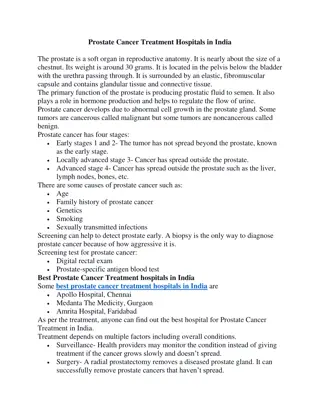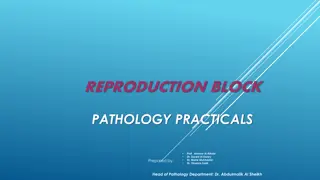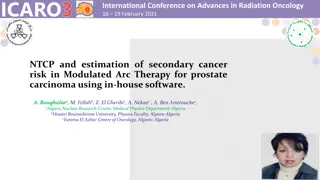Prostate Cancer
Prostate cancer is a serious health concern affecting many men, with symptoms such as frequent urination, pain while urinating, and blood in urine. Understanding the differences between BPH and prostate cancer is crucial for early detection. Diagnostic tests like digital rectal exam and PSA test are essential for accurate diagnosis. Factors influencing prognosis include cancer stage, patient's age, and treatment options. Staging and grading tests like bone scan and MRI help in determining the extent of cancer. Treatment options range from surgery to targeted therapy, with new options like cryosurgery and proton beam radiation therapy available. It's important to be vigilant about symptoms, get timely screenings, and explore various treatment avenues for managing prostate cancer effectively.
Download Presentation

Please find below an Image/Link to download the presentation.
The content on the website is provided AS IS for your information and personal use only. It may not be sold, licensed, or shared on other websites without obtaining consent from the author.If you encounter any issues during the download, it is possible that the publisher has removed the file from their server.
You are allowed to download the files provided on this website for personal or commercial use, subject to the condition that they are used lawfully. All files are the property of their respective owners.
The content on the website is provided AS IS for your information and personal use only. It may not be sold, licensed, or shared on other websites without obtaining consent from the author.
E N D
Presentation Transcript
Prostate Cancer Treatments By: Ishan Parikh
Symptoms Be on the look out for stop-and-go flow of urine Sudden urges to urinate Frequent urination (esp. at nights) Trouble starting urination Trouble with emptying bladder completely Pain or burning while urinating Blood where it does not belong Ongoing pain in the back, hips, or pelvis General tiredness, fast heartbeat, dizziness, paleness
Why those symptoms? You may have some prostate issues.. BPH (Benign Prostatic Hyperplasia) vs Prostate Cancer ~1 in 5 US men, mainly older, will be diagnosed with prostate cancer
Tests for diagnosis Digital Rectal Exam PSA (Prostate-specific antigen) test Transrectal ultrasound Transrectal biopsy
Factors for prognosis The chance of recovery depends on State of the cancer (PSA level, Gleason score, tumor grade, and stage of cancer) Patient s age Whether first diagnosis or recurrent The treatment options depend on Other health issues of patient Expected side effects of each treatment Past treatments influence new treatments The patients choice
Staging and Grading Previously discussed how cancer is staged and graded but what tests help in that process? Bone scan checks if cancer cells are in the bone by sending radioactive material to collect abnormal cells MRI using magnets and radio waves, makes a series of detailed pictures inside body CT (CAT scan) uses X-rays to make detailed pictures of body from different angles Pelvic lymphadenectomy remove lymph nodes to view tissue under microscope Seminal vesicle biopsy views fluid under microscope to look for cancer cells
Treatment Overview Current options Stages Watchful waiting, active surveillance Surgery Radiation therapy Chemotherapy Hormone therapy Biologic therapy uses patient s own immune system Bisphosphonate therapy drug for bone metastasis IV Targeted therapy drugs to target specific cells New Options (clinical trials) Cryosurgery High-intensity focused ultrasound Proton beam radiation therapy I, II, III, IV I, II, III, IV I, II, III, IV IV II, III, IV IV IV Stages I, II, III I, II II, III
Treatment options Watchful waiting Closely monitoring patient condition without giving treatment until symptoms show -Test results positive, but no symptoms Active Surveillance Closely following condition without treatment unless there are changes in test results -Symptoms and test results positive, but very low risk
Surgeries Retropubic prostatectomy incision made in abdominal wall Perineal prostatectomy incision made between scrotum and anus
Surgeries (cont) Transurethral resection of the prostate (TURP) helps in treating BPH by removing some tissue from prostate, but not all Holmium laser enucleation Problems Impotence Leakage of urine (Incontinence) Shortening penis Inguinal hernia
Radiation External makes a 3-D picture of tumor and beams are shaped to fit the tumor Internal (Brachytherapy) radioactive substance is placed near cancer. (strontium-89) Use ultrasound + CT to accurately place seeds Problems Impotence and urinary problems Increased risk of bladder or rectal cancer
Hormone therapy Many hormonal changes can help reduce size of prostate Main goal is to stop making testosterone Problems Hot flashes Impaired sexual function and loss of desire Weakened bones Other common side effects diarrhea, nausea, itching
Chemotherapy Widely used cancer treatment, but mostly for metastasized cancers Kills all newly growing cells in body -including bone marrow, lining of mouth and intestines, and hair follicles Problems Many side effects nausea, vomiting, diarrhea, lowered resistance to infection, easily bruised, fatigue Lowers white and red blood cells Most side-effects are short term
Bisphosphonate + Targeted + Biological therapies These are not fix-all cures, they are helpers Bisphosphonate - drugs help to reduce bone disease and pain when cancer spread to bones. Inhibit bone cell type that causes bone break down Treats osteoporesis Targeted therapy drugs that find and attack certain cells without harming others Hormone therapy is an example Biologic therapy uses own immune system to make more cells in a laboratory
Targeted Therapy Signal A > Hormone X Hormone Y > Hormone X If altering hormone Y does not work, then targeted therapies will alter signal A
Clinical trials Cryosurgery freezes and destroys cancer cells by using special instrument. Ultrasound is used to find area to be treated High-intensity focused ultrasound uses very high energy sound waves to try and destroy cancer cells. The cancer cells heat up and become destroyed Proton beam radiation uses high energy external radiation in streams of protons. Currently being studied
For more information. Visit https://www.cancer.gov http://www.youtube.com/watch?v=Xus8nrth7eM























